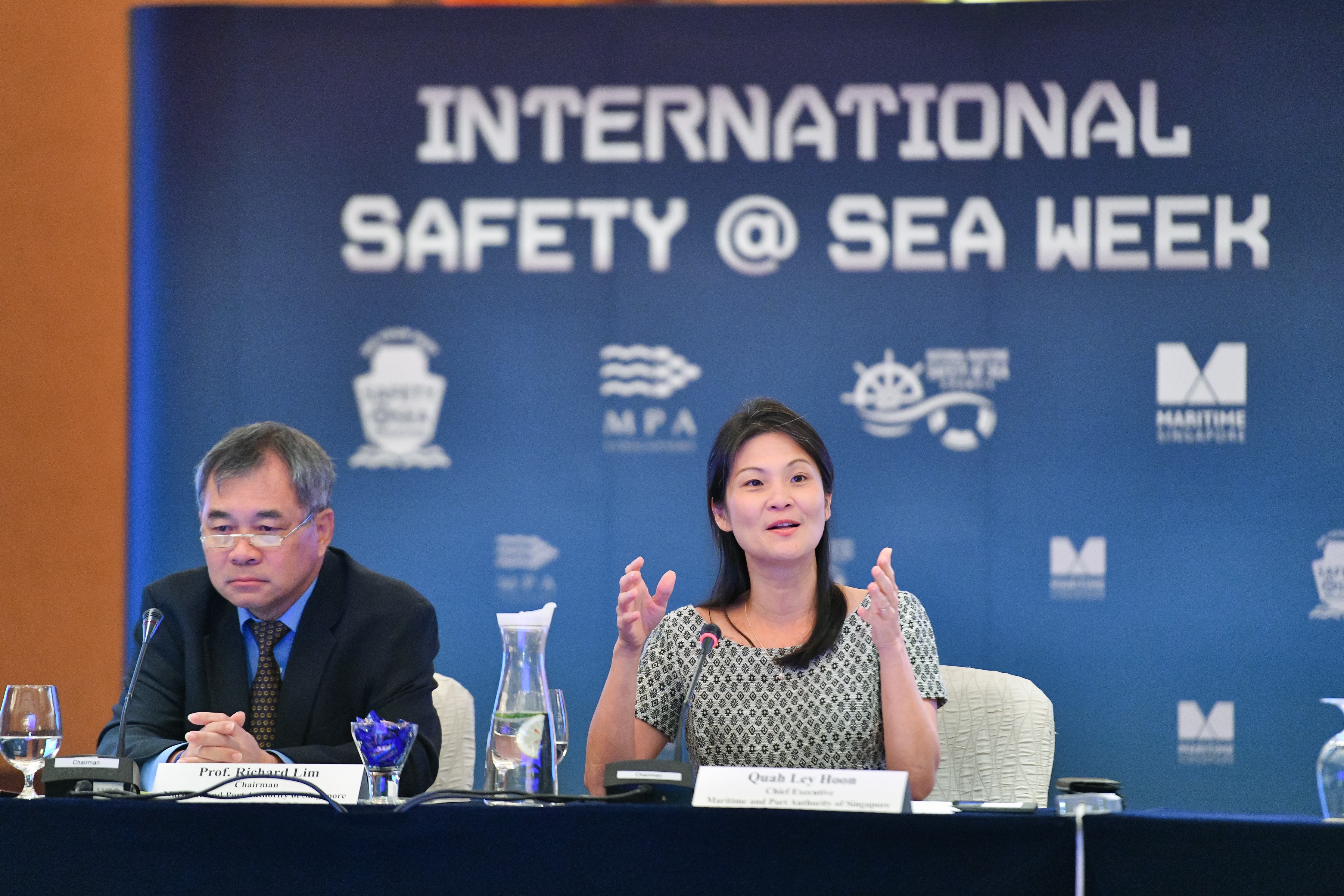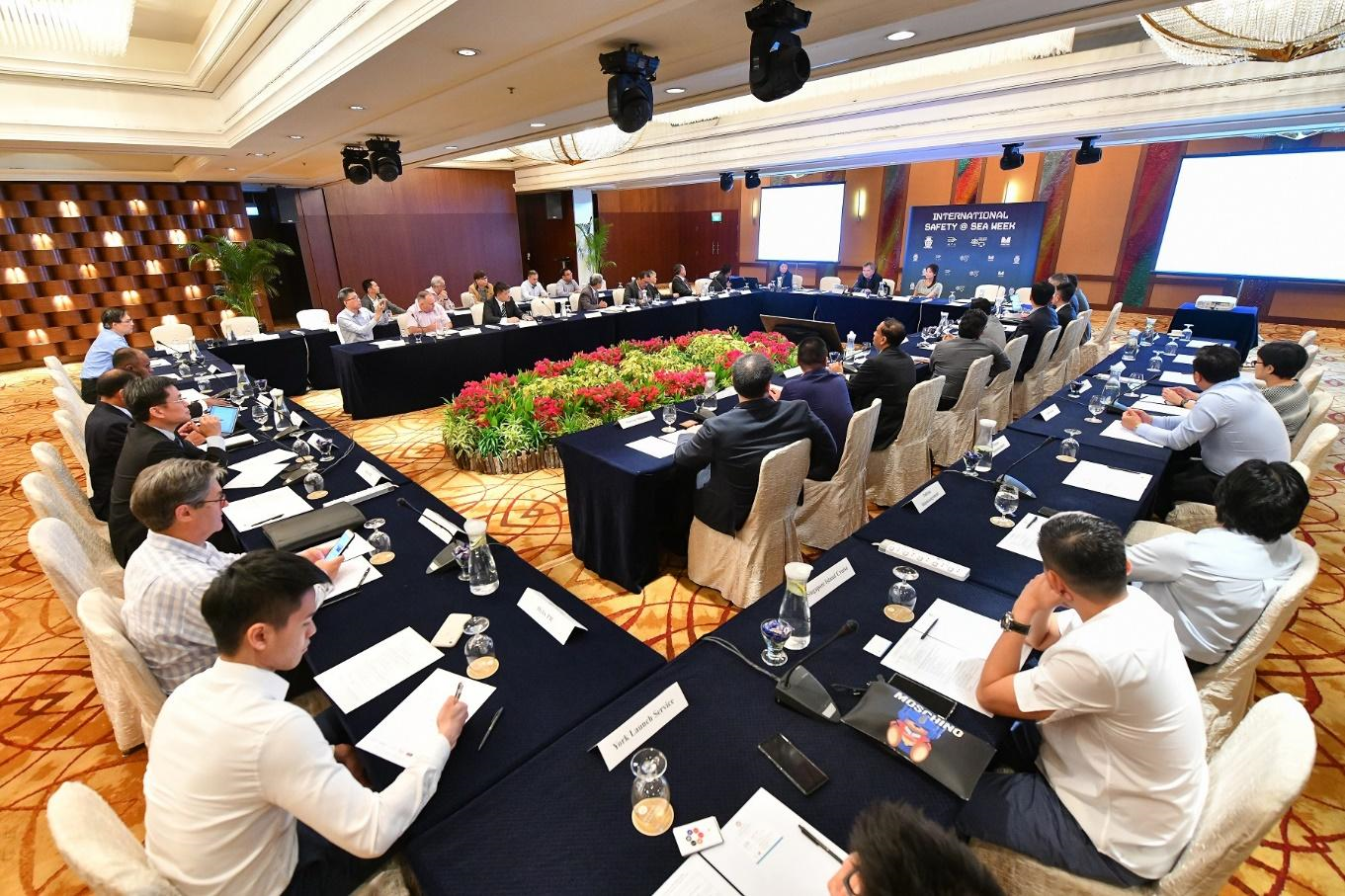
Professor Richard Lim, Chairman at the National Maritime Safety at Sea Council (left) and Ms Quah Ley Hoon, Maritime and Port Authority of Singapore (MPA) Chief Executive (right) at the CoP Forum
In her welcome remarks at the second Community of Practice (CoP) Forum on Maritime Safety, Ms Quah Ley Hoon, Maritime and Port Authority of Singapore (MPA) Chief Executive, stressed that in a marine incident, while cargo loss is replaceable, lives lost will be irreplaceable.
The second CoP forum took place on 28 August 2019 at the sixth annual International Safety@Sea week organised by MPA, which was held at the Marina Mandarin Hotel from 26 to 30 August 2019. This second CoP Forum served as a continuation to the inaugural edition in 2017, bringing the community together with the objectives as follows:
- To facilitate the sharing of knowledge and best practices to enhance safety standards;
- To distil and proliferate knowledge on maritime safety; and
- To share best safety practices which can be adapted and translated into salient takeaways and practicable solutions by participating delegate nations and industry stakeholders
While new ferry safety initiatives, digital solutions and innovative technologies were explored, issues related to human factor drew strong interest at the forum, which saw delegates from China, Indonesia, Lao PDR, Malaysia, Myanmar, New Zealand, Singapore and South Korea, as well as stakeholders in the ferry industry.
The forum kicked off with a sharing session from participants of the inaugural CoP Forum, each providing a candid update on its successes and challenges faced since the first CoP - setting the stage for more frank discussions to take place throughout the rest of the day.

Delegates from Singapore and the region gathered at the CoP forum to discuss on ferry safety issues
Overloading: a human issue
Of the recent major ferry incidents shared by the participants, overcrowding was attributed as the main cause of accidents in Asia.
Overcrowding typically occurs when demand far outstripped the supply of ferries. As the demand for ferry services is very dynamic and fluctuates based on seasonal peaks, it can be particularly challenging for operators during festive periods when families return to their hometown.
The problem of overcrowding persists due to the low levels of safety awareness coupled with deficiencies in implementation and enforcement of national regulations.
This was also echoed by another delegate who shared that overloading was found to be one of the key factors that led to a ferry sinking incident. While the ferry was only licensed to carry 36 passengers, approximately 230 people were on board during the incident, which saw dozens of deaths.
Similarly, in the 2014 Sewol ferry disaster, there were 304 casualties when the vessel sank due to overloading by the crew. Five years on, the tragedy still remains a source of grief as most of the victims were students.
Complacency among crew an issue
Although overloading is less of an issue for other nations, one delegate shared that complacency among seafarers still persist. As an example, goods which are not hazardous on the road may become a hazard at sea, and shipboard crew are not taking these hazards into consideration when shipped as cargo.
In response to combating complacency, a delegate emphasised the importance of preventive measures and emergency preparedness. A good practice would be to conduct detailed inspections and random spot checks to test crew competency and readiness in responding to emergency situations. Most importantly, these inspections should test the crew's ability to use safety equipment such as fire extinguishers, and a crucial factor is to test speed of response for when and if a real fire breaks out on board.
Educate passengers, not just the crew
Despite the differences in culture and systems, the session brought forth new solutions in the face of new challenges. The buck does not stop with the ferry operators and the maritime administrators; it requires the inputs of everyone in the ferry industry - passengers included.
An industry delegate stressed on the need to reset the safety culture as a whole, citing safety education as essential for not just the maritime community, but perhaps even more so for passengers.
Professor Richard Lim, Chairman at the National Maritime Safety at Sea Council also explored the concept of "qualifying" passengers when promoting safety. "Today, more people are going out to sea for holidays and other recreational purposes, but they have no idea of the dangers of the sea. This poses a significant issue in maritime safety that we need to address," he said.
Technology to close the safety gap
Besides raising safety awareness among the crew and passengers, many participants acknowledged the role technology has played to fill in the gaps. For example, in Indonesia, the e-ticketing system has been introduced to address the overcrowding issue and account for the passengers on board, especially in the event of an accident. And in Singapore, the use of video analytics has been explored to detect hazards and identify blocked passageways.
Industry players have also stepped forth to present their perspective on improving ferry safety at the forum. Ferry operator Batam Fast recently trialled a safety demonstration video using holographic telepresence technology to teach passengers how to don a lifejacket correctly. Not only was the three-dimensional video highly realistic, real-time analytics data i.e. viewership, can also be collected.
A promise to reduce ferry fatalities in two years
In his closing speech, Mr David Foo, Director (Ops-Tech Division), MPA, summed up the forum by saying, "Having attended the first forum, I can see that there is more sharing this time round. It is indeed heartening to see the community come together and becoming a lot more open. We see concrete initiatives being put in place since the last forum and it is an encouraging sign for all of us."
"However, we still need to do more to reduce the number of ferry fatalities and hopefully when we meet the next time, we can happily report that there is a definite decline in such fatalities," he said.

